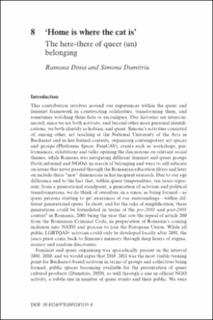| dc.contributor.advisor | Engebretsen, Elisabeth L. | |
| dc.contributor.advisor | Liinason, Mia | |
| dc.contributor.author | Dima, Ramona | |
| dc.contributor.author | Dumitriu, Simona | |
| dc.date.accessioned | 2023-06-16T08:32:06Z | |
| dc.date.available | 2023-06-16T08:32:06Z | |
| dc.date.created | 2023-01-27T14:39:33Z | |
| dc.date.issued | 2023-08 | |
| dc.identifier.citation | Dima, R., Dumitriu, S. (2023) ‘Home is where the cat is’: The here-there of queer (un)belonging. In E.L. Engebretsen, & M. Liinason (Eds.), Transforming Identities in Contemporary Europe Critical Essays on Knowledge, Inequality and Belonging. Routledge. https://doi.org/10.4324/9781003245155 | en_US |
| dc.identifier.isbn | 9781032151113 | |
| dc.identifier.uri | https://hdl.handle.net/11250/3071738 | |
| dc.description.abstract | This chapter builds on the diasporic status the authors acquired once relocated from Romania to Sweden. It marks the reference point and position for a self-reflective study constituted in the form of vignettes that stem from personal experiences on belonging and un-belonging in queer spaces, migration and community forming in a new space from a comparative perspective based on the authors’ experiences in both countries. This adds to the existing literature on gender, diasporas and migration. Furthermore, it offers an insight into the construction of certain elements with regard to a “queer Romanian diaspora” and how the transformations experienced in terms of losing certain aspects of an “activist self” become relevant within the transnational research frameworks. This contribution thus frames the authors’ de-construction and re-construction of activist and migrant identities by refusing and rethinking the usual binaries operating within the methodological nationalism predominant in migration studies and see “identities” more as “as a process of multiple relationalities”. Focusing on concepts such as “diaspora”, “solidarities”, “opting out” and “homonationalism”, the authors use queer retrosexuality to construct a fragmented critical story by using the mechanism of “looking back” to their shared past, finding connections within the present, often interrupted by small but meaningful glimpses of interactions in different life situations. One purpose is to understand the borders of queerness in the chosen contexts. The other is to explore and make sense of the different configurations the authors’ activist selves have taken over time. | en_US |
| dc.language.iso | eng | en_US |
| dc.publisher | Routledge | en_US |
| dc.relation.ispartof | Transforming identities in contemporary Europe : Critical essays on knowledge, inequality and belonging | |
| dc.rights | Attribution-NonCommercial-NoDerivatives 4.0 Internasjonal | * |
| dc.rights.uri | http://creativecommons.org/licenses/by-nc-nd/4.0/deed.no | * |
| dc.subject | feminisme | en_US |
| dc.subject | feminism | en_US |
| dc.subject | queer diaspora | en_US |
| dc.subject | kjønnsstudier | en_US |
| dc.subject | migrasjon | en_US |
| dc.title | ‘Home is where the cat is’: The here-there of queer (un)belonging | en_US |
| dc.type | Chapter | en_US |
| dc.description.version | publishedVersion | en_US |
| dc.subject.nsi | VDP::Samfunnsvitenskap: 200::Kvinne- og kjønnsstudier: 370 | en_US |
| dc.identifier.doi | 10.4324/9781003245155-8 | |
| dc.identifier.cristin | 2116766 | |
| cristin.ispublished | true | |
| cristin.fulltext | original | |
| cristin.qualitycode | 2 | |

